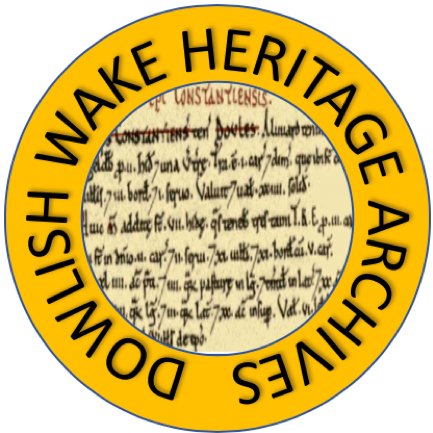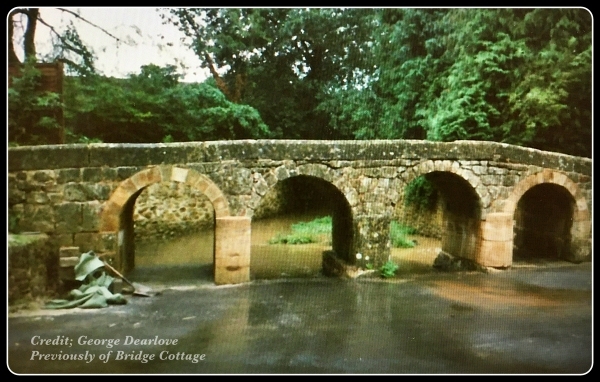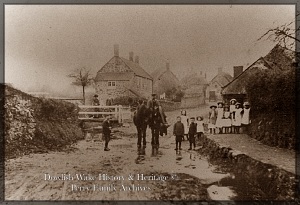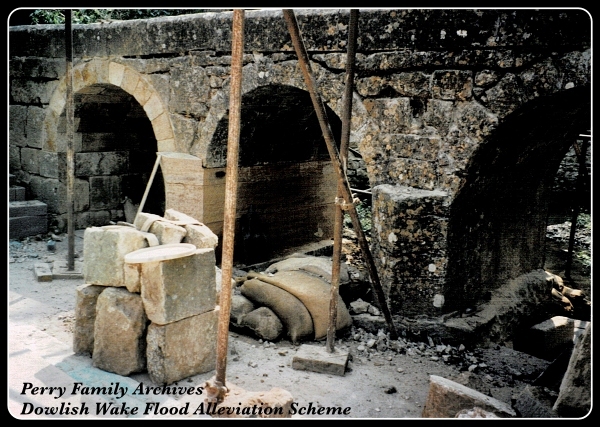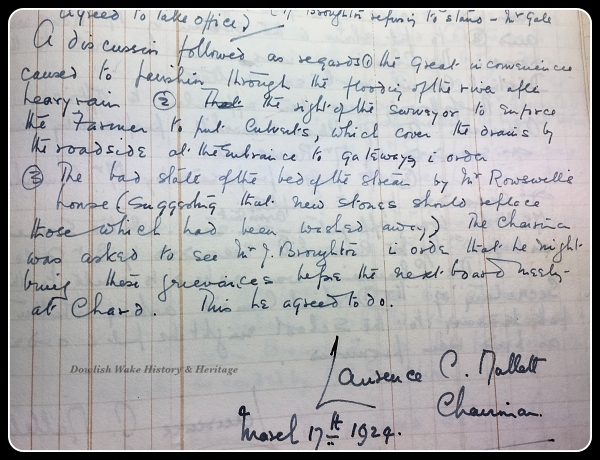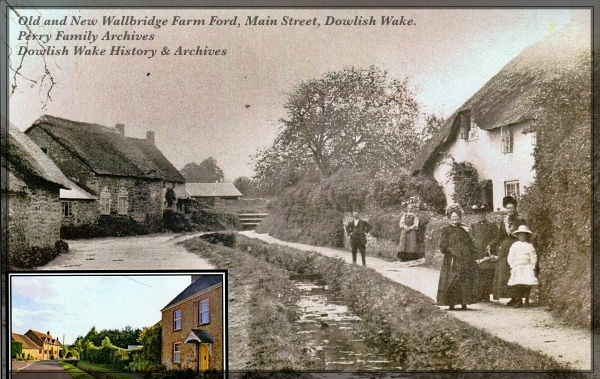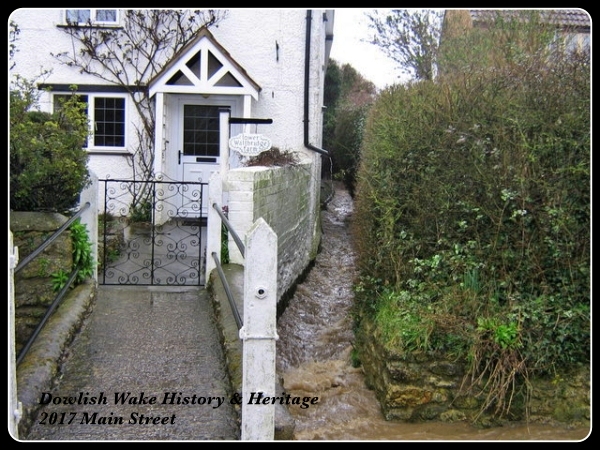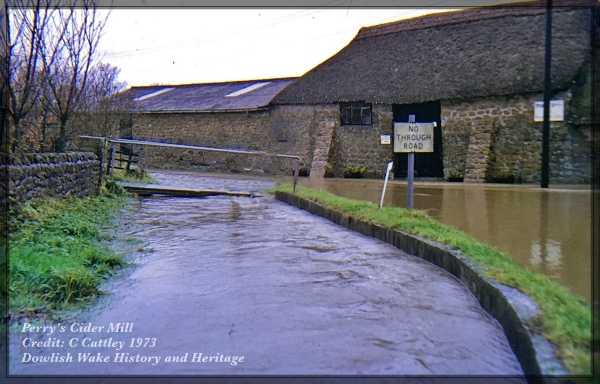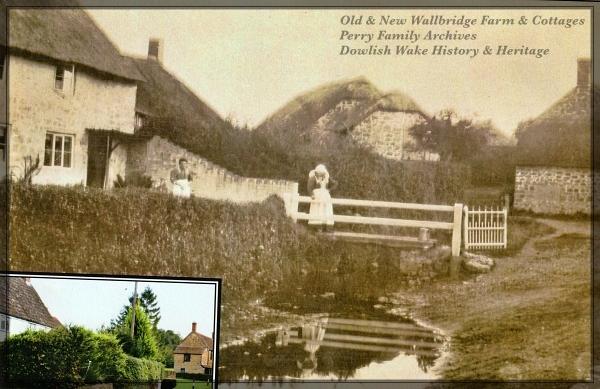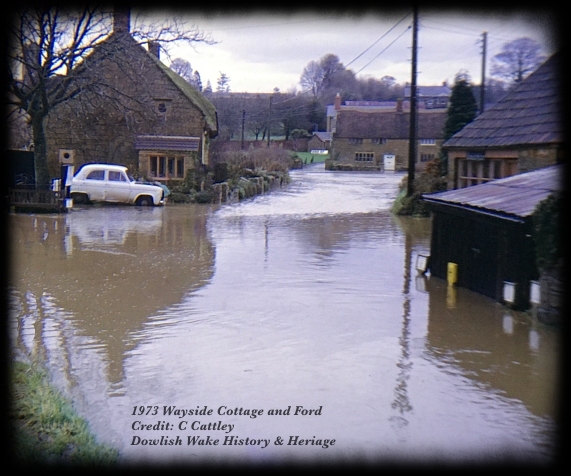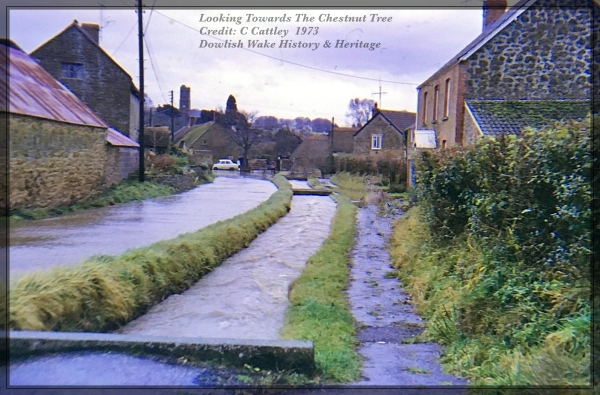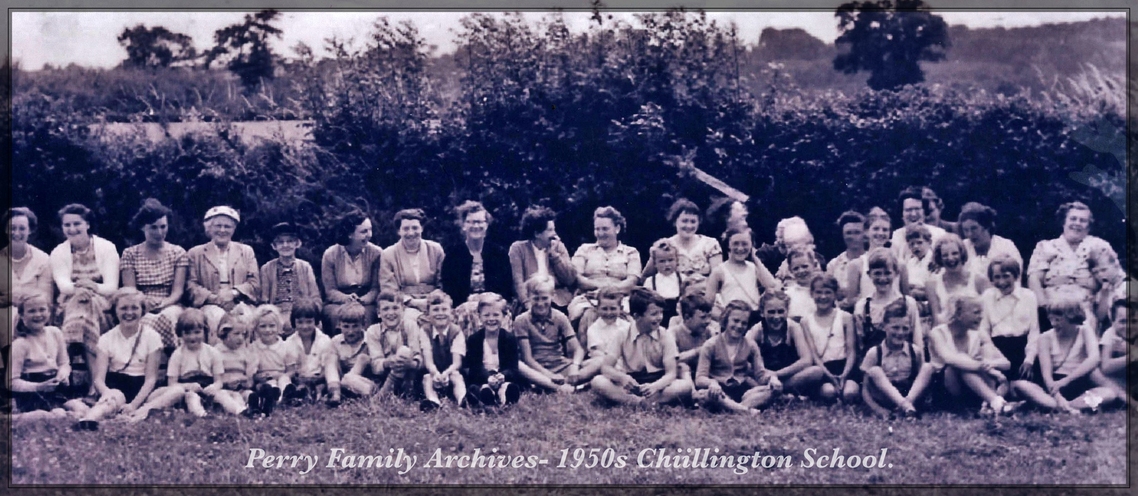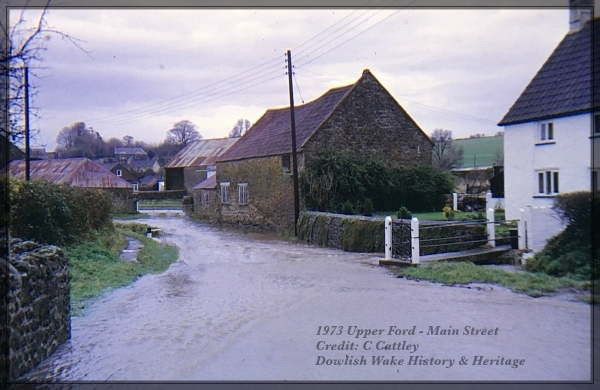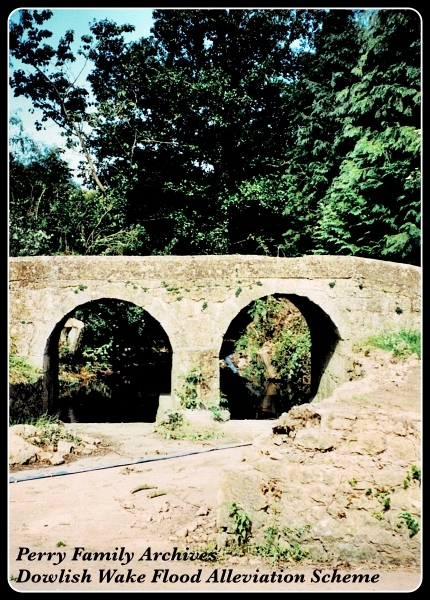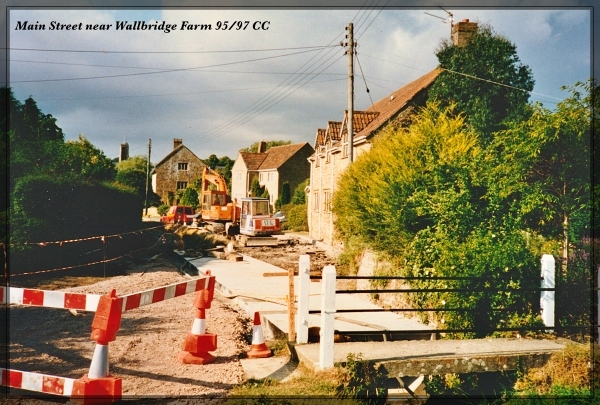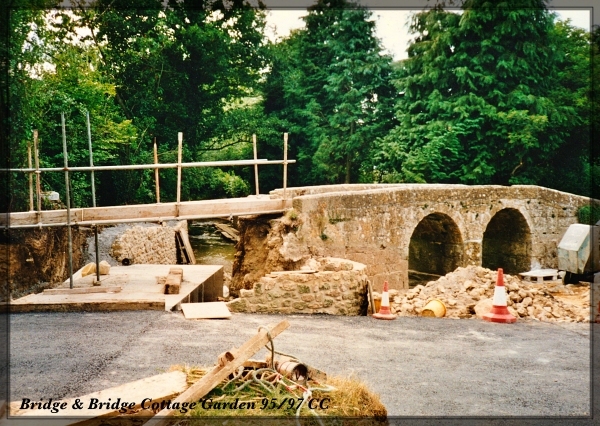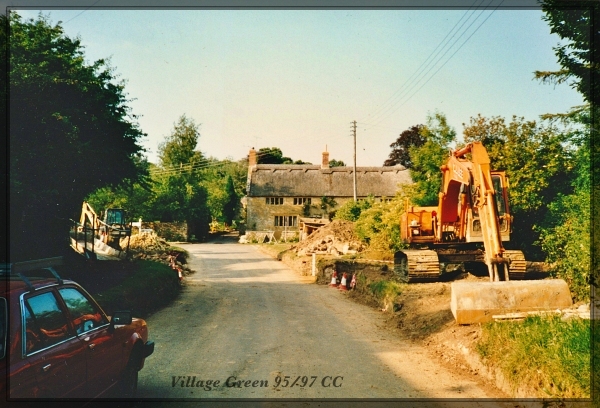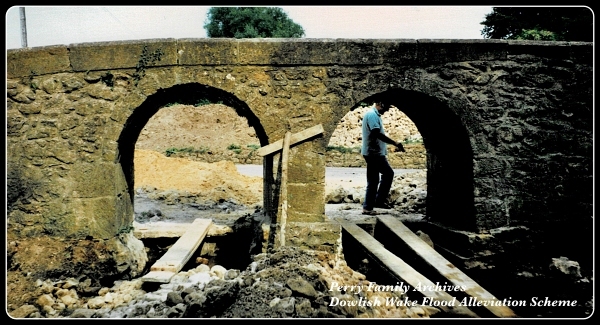Dowlish Brook & The Flood Alleviation Scheme of 1997
Improvements to Packhorse Bridge & Village Fords
South Somerset District Council & Somerset County Council, in June 1997, completed flood relief work in Dowlish Wake. The two stages of long-awaited improvements were greatly welcomed by residents.
The first stage replacing the ‘upper’ Ford at Wallbridge Farm with culverts and deep-walled channelling of the open stream. Here, the road surface was muddy and slippery and, at times, a real danger. By 1942, motorised vehicles sometimes slipped off the road into the stream.
The second stage was the addition of two further arches to the Grade II Packhorse Bridge, plus work on the Ford crossing next to it, known as 'Lower Ford'. The Ford surface much improved, and under it, a substantial bypass culvert. These two improvements enabled the road through Dowlish Wake to be kept open year-round.
Over many years, the annoying flooding of Dowlish roads was formally recorded in parish meetings held either in the vestry or the school room. The recorded minutes of meetings, handed down through village archives, illustrate year by year the lengths taken to end the nuisance. As an aside, it's interesting to read the path which led up to Church and School, the path with its railings, referred to as ‘The Causeway”. [The school later becoming Speke Hall]
The Dowlish Wake Vestry book in our archives, records the nomination and appointment of villagers, who act as Overseers of the Poor and Church Wardens. Thus, an elected parish council was formed. Representing the parish church and the owner of the Dowlish Wake estate, the Speke family. These elected parishioners, responsible for caring for the poor, collecting tithes and generally keeping order, along with the spiritual and well-being of the village residents.
By 1920, the minutes in our archives started to record discussions on topics such as the use and administration of the Allotment Fields, long used by village men. The administration of this and other activities in 1920, needing to be decided by the villagers themselves. This was due to Major Speke severing connections that year with his tenants, following the successful auctioning and sale of the Dowlish Wake Manor Estate. The estate was broken up with many successful bidders, former tenants of Speke.
At this time, rural society was also moving to civil responsibility. Each parish working with rural and county councils, the latter newly formed. Local authority bodies were gradually taking on civil duties and could provide services. Be they building houses or installing a proper water supply in each household. Of interest to Dowlish Wake in this article is the Highways Committee, the provision, maintenance and protection of the condition of roads and drainage.
The Dowlish Wake parish council meetings were becoming well attended, the problem the most prominent, flooding. Points raised were directed at council surveyors, site visits were made, and councils debated liability, expenditure, and targets.
Dowlish Wake paper records are awash with related matters. In 1923, the stream-bed stones washed away in a storm. In other years, repeated complaints: culverts needing cleaning out, collapsed drains, gullies and ditches, streamside walls washed away. Many times, voicing ‘ the fords were dangerous and impassable’.
In 1930, no scheme had been put forward regarding the old bridge, apart from requesting a concrete ford to improve the situation but not so as to interfere with the bridge.
In 1931, the same grievances. But an added problem was the surge of water caused when the mill hatches were opened too late in heavy rain. The mill by now, unused, the resident responsible for operating the hatches, a Mrs Pike. She was a tenant of the owner, Mr Symonds. He promised to address the matter.
February, 24th of 1931, Devon & Exeter Gazette, published news concerning Chard Rural Council Finance Committee, who had sanctioned a loan for provision of a Water Supply at Dowlish Wake Water supply, a sum of £550.
In 1932, the hatches at the disused Mill were still not being opened despite an order to do so. Mrs Pike was then instructed to open the hatches once a day, during wet periods. She was to use her judgement to avoid letting down a flood, because doing so, created accumulations of mud.
A novel idea for flood alleviation was put forward in 1932. This at a Special Meeting in the January. Mr Churchill proposed:
"This meeting strongly desires a second bridge to be constructed on the lower side of the present one". "We are of the opinion that the present scheme, under consideration will not serve its purpose. It would be distracting from the archaeological beauty of the present Packhorse bridge. We authorise the cost of the Scheme to be diverted to this project".
Seconded by Mr Perry, the resolution passed. However, after the great excitement, the second bridge is no longer mentioned in records.
Also in 1932, villagers had put a great deal of effort into gaining evidence from users of the village in Dowlish Wake. Organising a petition which was signed by 154 users. They were requesting:
"Construction of an efficient means of crossing Dowlish Wake Fords for all users, including, vehicular traffic”.
They were informed that a sum of £300 had been estimated for a concrete ford, however, this work awaiting the Highways Committee schedule.
Repeatedly mentioned was the muddy path over and along by the Packhorse Bridge. Otherwise in the village, some work seems to have been carried out, as in 1933, there were complaints of a large number of discarded bricks, broken pipes, and cement bags littering the sides of the roadway.
“Perhaps the council could reuse the bricks somewhere else and take note the drain gratings are six inches above the road surface and serving no purpose, furthermore the soft soil catch-pits have all but washed away”.
Another Ford, needing repair and mentioned in the minutes was that at Ketchell’s Lane Ford.
As an aside, in 1937, the district council offered a 3 weekly refuse collection. In answer;
“ That this parish rejects the scheme as being unnecessary in Dowlish Wake”. [the council rate would have to rise], "an additional item on the Rates". Then, in 1939, "a fortnightly collection could be useful after all" at the cost of an additional penny on the half-year rates. The resolution carried unanimously; Dowlish Wake “desired to join the ‘District House Refuse Collection Scheme”.
Arthur Mee, visiting in 1941, found Dowlish Wake a pretty village, “with a shallow mill-stream, one of the sources of the River Isle, the stream flowed across the road, dividing the village of Dowlish Wake in two. Horses and Carts must ford, but there is a stone bridge for those who walk'.
In 1942, we had motorcycles and lorries falling in the stream, conversations turning to whose liability and if the Packhorse Bridge was an ancient monument. Enquires were made and Somerset Archaeological Society were approached.
It's 1944, and the wartime ‘Blackout’ restrictions lifted, but Wallbridge Farm Ford is still a 'danger spot; we need warning signs'.
November 1946, a crowded schoolroom, a 'special meeting', almost as an ‘after-thought', mention of flooding at the top of the village. With those present seemingly concentrating on other needs; provision of a new Village Hall along with the need for a late-return bus service from Dowlish to Taunton. The bus company would be consulted.
It was in 1948, under an earlier local Government Act, that the required prescribed more rigid type of Parish Council was formed. Many rules and Regulations. Formally created, stamped and authenticated, under ‘Common Seal of the Somerset County Council’. Thus bringing 'local district rates payable' & the attending of Dowlish Wake representatives at various meetings oft Chard Council. The meeting summarised; "Now that a parish council is in existence, matters could and should be referred to that body of the council for deliberation".
In 1948, Dowlish Wake Parish, following stipulated rules, elected seven Dowlish Wake Parish Councillors.
Raymond Samuel Tudor [Chairman]
John Holland
Harold Rupert Sumption
Charles Henry Pattermore
William Wood
Hubert Rigg-Stansfield [Clerk]
John Henry Board.
The "Local Government Acts for Parish Councils" rulebook much read! On August 17th 1948, their first meeting, a clear agenda: Open Stream through the village
"The above open channelled stream, it was stated, was causing a nuisance, and it was suggested that the Clerk approach the Chard R.D. Council [through Mr Dommett] asking "if this nuisance could be abated by suitable improvements in cleansing, such as being cleaned out every fortnight]”.
In 1949, the Chard council agreed to regularly cleansing the upper Ford. Dr Court [Ministry of Health] was to report on the sewage problem. Very soon, they heard that Mr A.J. Allen, a consulting engineer from Sherbourne, had been instructed to prepare a scheme.
1949 was also the year Somerset County Education Council proposed a closing order on Chillington School. Dowlish Wake primary school children still shared this school.
1959, January, discussed again, the steam/open drain running through Main Street, the matter raised by Mr Perry. The emphasis now on the sewage that was at times apparent in the open stream. Other villages nearby were having installed Sewage Works. For what ever reason, the Dowlish Wake minutes recorded the comment;
“It was agreed by all, that the time was not ripe for any major works, but it was agreed to ask the R.D.C. [and especially, Mr Whisker] to assist in considering a modified scheme”.
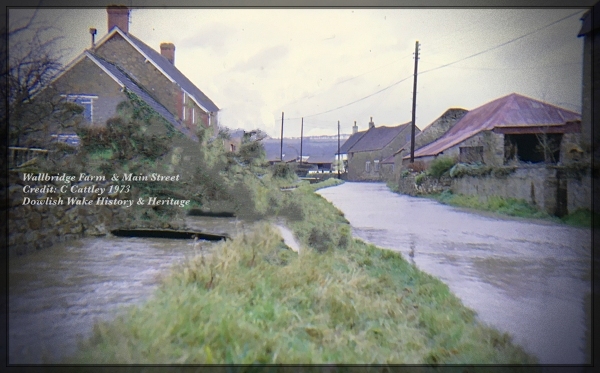
Of Interest is 'The Packhorse Bridge' in Dowlish Wake becoming Grade II listed building on February 4th 1958.
Packhorse Bridge, Dowlish Wake, Somerset, TA19. In the Civil Parish of Dowlish Wake.
British Listed Buildings, [see britishlistedbuildings.co.uk Website ID 101366407. Source 1366407, Source Historic Buildings, English Heritage Legacy ID 262166].
National Heritage listing for England: Historic England, Packhorse Bridge in Dowlish Wake. See historicengland.org.uk Entry No 1366407
In May 1959, the D.W.P.C meeting welcomed Mr Whisker, addressing the problem of raw sewage in streams; he spoke of budgets and loans being a hindrance and that local energies were concentrating on Water Supplies to homes. The gathered residents made it clear they were not prepared to wait and pressed for temporary measures. Those gathered proceeded to the open stream and the various pipe outfalls. After some thought, Mr Whisker suggested a 4-inch pipe could be run from Mr Rowswell’s gate to a point beyond the footpath by the Old Parsonage. He assured them otherwise that Dowlish Wake was fourth on the list!
In January 1960, the clerk produced a ‘confidential’ report of the R.D.C. sub-committee concerning Government reorganisation. But as there was nothing that the members had not read in the press, and none of the items concerned Dowlish Wake, it was allowed to remain on the table! But were glad to view the suggested plans for a sewage scheme, just a few reservations about the siting of the treatment works, which was to be built near the stream, behind the Old Parsonage. The body of the Scheme, allowed for three sewers to be laid, starting at Rectory Corner, then Mill Farm with Meadow View, Primroses Villa and down to Oxenford. Kingstone being ‘sewered’ as an extension later.
March 1960 was the first mention of the S.W. Gas Board in Dowlish Wake, even if only complaining that their operatives had left cover holes uncovered overnight. No mention of flooding in these minutes but a request from Mr Taylor for the village to provide a Youth Club. By now in 1960 the parish council were hosting four meetings a year. Later in the year, October’s; Mr Perry enquiring if the 'Dowlish Sewage Scheme' had been forgotten by the council. No, it was just the slowness of Government grants to the local councils. Mr Beeston and Mr Vickery agreed to approach R.D.C. for more frequent cleansing of gullies and roads. Fed up with residents' flooding complaints and the long detour for all in heavy rain, making fords are impassable. Members were dismayed that the road brush lorry drove through the village daily, but the brushes were never dropped!
1961, we see that Chillington Primary School is still being considered for closure. Children from Dowlish Wake shared this school with Chillington children.
Sewage Works still not installed. But in April 1962, the chairman, Mr Holland, conveyed news that Dowlish Wake Sewage works were next on the list. In March, the retaining wall of the stream outside Brookside House needed repair. Later, members heard that the Dowlish Wake Sewage Works project was demoted due to priority given to Combe St Nicholas.
In 1962, entries end in the book we have been consulting, this the village archived Vestry / Poor Rate / Parish Meetings book, used for all these years. This book over years fulfilling grand duty, the volume up-ended, the clerks writing on the reverse of the original pages.
September 3rd 1984: An article printed in the Bristol Evening Post.
“Scheme to End Flood Chaos in Dowlish Wake. A £148,000 proposed scheme could solve the problem of three small villages near Ilminster. Dowlish Ford, Dowlish Wake and the hamlet of Sea. Often hit by flash floods up to two feet deep. The problems are caused by inadequate culvert systems that carry the Dowlish Brook. Yeovil District Council Health Committee will be told on Thursday that the Scheme could cope with a storm so severe, a once every 25 years storm”.
On November 13th, 1987, the South Somerset Council inserted an advert in 'The Western Gazette', Inviting applications for a Dowlish Wake Flood Alleviation Scheme. Experienced contractors were required to tender for the above Scheme. Details:
- Regrading 1500 meters of Existing stream.
- Laying of 200 meters of Box Culverts/Pipework.
- Bank Protection.
- Headwalls and cutting new drainage channels.
Deadline: Wednesday, November 25th 1987.
Apply to Chief Technical Officer.
November 21st 1989 – Notification of a Planning Application - Copy of which in Archives
South Somerset District Council - Dowlish Wake Flood Alleviation Scheme.
Application no 893322
November 21st 1989 - Chief Planning Officer L J Clotworthy
Proposal
Dowlish Brook Flood Alleviation Scheme – Stage 2 Regulation [7 & 13 Listed Building Consent].
Location: Land at Lower Ford – Dowlish Wake. The formation of two additional arches in Packhorse Bridge.
Bristol Evening Post, March 26th 1991.
Headline: Villagers fury over Flood Risk.
Speaking of the delays to a £250,000 scheme, Parish Council Chairman John Perry warned that lives could be put at risk. He told of the problems the villagers had been fighting for over 30 years. "Now, the work is to be put back a year due to South Somerset District Council's ongoing negotiations with English Heritage". He told of 30 houses marooned when the two fords flooded. People rescued from cars swept into the water. Six houses flooded three times in three years. " We just wish the design could be sorted out. The bridge is important to the village, but so is an end to floods".
September 28th 1992 – Paddy Ashdown M.P.
Dowlish Wake Flood Alleviation Scheme.
Correspondence between Mr John Whiting, S.S.C.C. Technical Services Manager, and Paddy Ashdown, M.P.
P. Ashdown visited Dowlish Wake, September 22nd on his roving surgery, speaking to residents and parish council members. "their frustration and anger over the apparent delays is an understatement; I share these frustrations". In his ten years as an M.P., he had witnessed the delays and broken promises. The money promised, the work committed, and finances allocated in both 1990/1 and 1991/93. Mr Perry and Mr Dearlove were considering withdrawing consent of the use of their lands. Paddy requested a site visit and answers to his questions:
- If this money was committed in the year 1992/1993, when is it going to be spent
- What is the hold-up, if there is any
- If there is no hold-up, when will work start
- If there is a hold-up, where does it now lie
- Is there any action I can take- By pressing English Heritage or the County Council
November 13th 1992 – Correspondence from Mr Meacham to Mrs Perry.
Dowlish Wake Flood Alleviation Scheme.
He referred to the Councils Committee meeting on November 10th and their committee's agreement of the Dowlish Wake Scheme as the first priority in 1993/4. Subject, of course, to various planning, grant aid and Ministry financial approvals.
“This decision was, I feel, arrived at in the light of the various representations from yourself and others in the village, making the committee aware of the problems in Dowlish'. The design works, we are now able to re-commence and I would, subject to approvals being forthcoming, anticipate work on site commencing in late 1993. I shall, of course. be speaking to you in due course to discuss in detail the works as they affect your property”.
It was not until 1995 and 1997, that Dowlish Wake saw work begin and be completed to alleviate the previous flooding. The formation of two extra arches to the Packhorse Bridge and its rebuilding, together with improvements to both fords, light at the end of the tunnel for Dowlish Wake.
In 1998, the House of Commons heard of the relief works completed in Dowlish Wake, from Councillor Humphrey Temperley, while he and others were debating flood and coastal defences.
The occasion Examination of Witnesses [Questions 260-279]
Tuesday, May 12th 1998
“Three or four houses at the bottom of a village may get flooded. In one Scheme we have just completed at Dowlish Wake a Cider Factory and four listed buildings were protected at a cost of something like £250,000. It is those kinds of schemes which are likely not to take place, and that is a great shame".
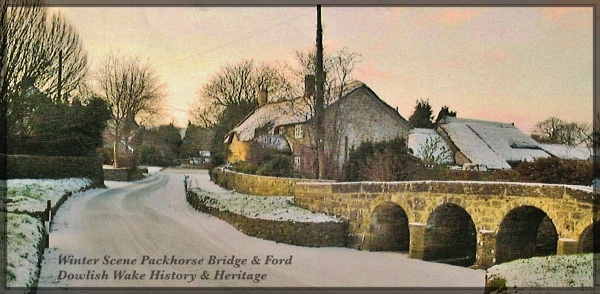
The work completed, the packhorse bridge looks splendid and is cleverly rebuilt; the insertion of the two extra arches and the stonework involved is exceptional. Once the root of the problem, as John Perry said in 1991, the pretty bridge is now proudly Dowlish Wakes' most significant asset, or is it the Cider?
Nevertheless, for those in Dowlish Wake, the flooding problem was mostly solved, but success was hard won.
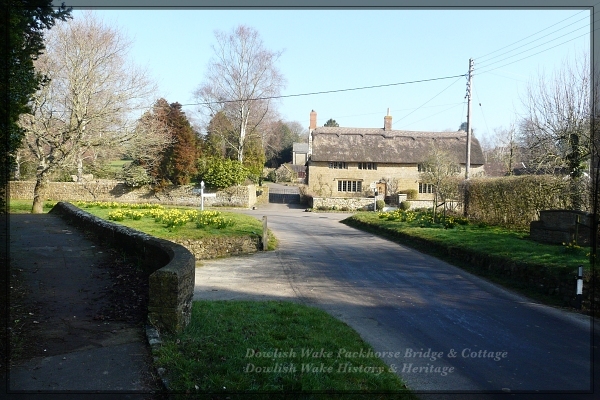
Further reading and sources:
It has been suggested that rebuilding the stone bridge around 1700, the design allowing for smaller arches, contributed to the excessive flooding all those years. Residents on foot, horse, cart and mechanical vehicles enduring flooded roads and fords impassable.
For all things Archaeological concerning Dowlish Wake Packhorse Bridge, visit;
"A Medieval Packhorse Bridge at Dowlish Wake, near Ilminster"
This very interesting report by Alan Graham which is available online at; sanhs.org
Newspaper records -The British Newspaper Archive – Find my past Subscription website. findmypast.co.uk
Dowlish Wakes Water supply of £550. - February 24th of 1931, the Devon and Exeter Gazette.
Record from Dowlish Wake Heritage archives:
November 21st 1989 – Notification of Planning Application from South Somerset District Council
Copy Letter Paddy Ashdown to John Whiting
Copy South Somerset District Council letter to Mrs Perry
John Perry, the root of the problem; Evening Post, Tuesday, March 26th 1991.
Arthur Mee was a journalist and writer from 1875 to 1943. Somerset Magazine August 2001.
Councillor Temperley, Item 273,
Debate May 12th, 1998.
House of Commons – Agriculture- Minutes of evidence
[Website; publications.parliament.uk]
In the debate, Temperley gave Dowlish Wake as an example.
[Flood Defence Committee, backlog of work, discussing of minor works, maintenance, applications, purse strings, Temperley favouring a block grant system on a regional basis appropriate].

